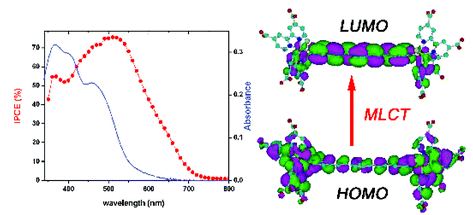We synthesized a novel series of compounds based on a ruthenium(II) dicarboxybipyridine (dcbpy) complex containing chloro and trans-1,4-bis[2-(4-pyridyl)ethenyl]benzene (BPEB) ligands. The binuclear species Na6[{[RuII(dcbpy)2Cl}2(BPEB)] exhibits an electrochromic effect when reduced, which is assigned to the radical BPEB0/˙, similarly as in viologen-based compounds. The carboxylate groups on the 4,4′ positions of bipyridine allow a strong attachment to the TiO2 surface, contributing to an efficient and reversible electron transfer from the oxide to the chromophoric ligand, coloring the oxide film blue. The coloration efficiency CE(λ) at 633 nm was 109 cm2 C−1, which is high compared to TiO2 itself. The complex also exhibits a high photon-to-electron conversion efficiency (IPCE > 70%) when applied as a photoanode in a dye sensitized solar cell (DSSC).
You have access to this article
 Please wait while we load your content...
Something went wrong. Try again?
Please wait while we load your content...
Something went wrong. Try again?


 Please wait while we load your content...
Please wait while we load your content...